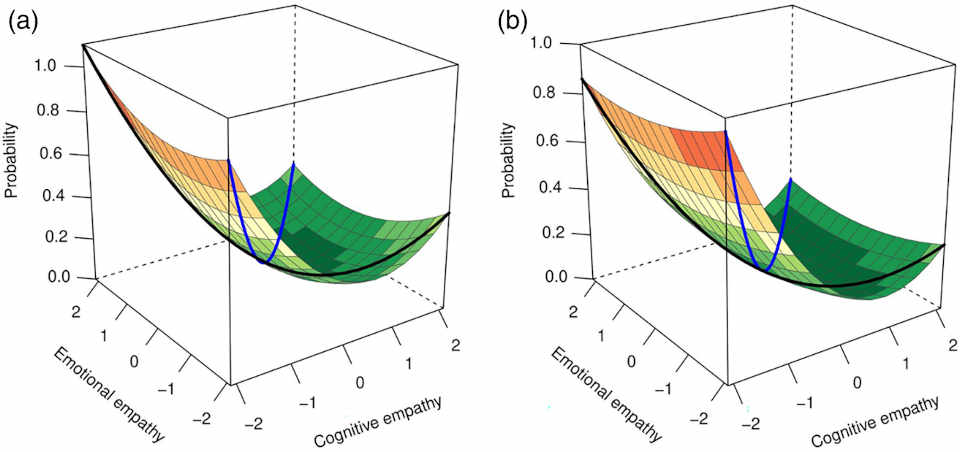Empathic disequilibrium is a new index combining two different types of empathy. The theory was proposed by a research team at Ben-Gurion University of the Negev as a method of predicting autism and autistic traits.
It is believed that affective and cognitive processes are both involved in the capacity to empathize with others. The degree to which one can sense or implicitly recognize the emotions of others is known as emotional, or affective empathy. Sensing other people’s emotions in difficult circumstances may arouse concern and compassion, which may then inspire them to approach and offer support.
Cognitive empathy, the ability to recognize other people’s mental states, is more intellectual in nature and do not necessarily require sensing the feelings of others.
Previous studies typically, though not always, revealed deficits in cognitive empathy in people with autism. However, there have been instances where some autistic individuals have said they have excessive empathy.
Emotional Empathy And Cognitive Empathy
The two types of empathy have different developmental, neural, and genetic pathways and are based on distinct yet related neurobiological mechanisms.
For example, emotional empathy first manifests very early in life and either remains stable or slightly increases during the second year of life. In contrast, cognitive empathy matures later in the first year of life and grows over time.
Also, neuroimaging studies show that the amygdala and cingulate cortex are involved in emotional empathy, while the ventromedial prefrontal cortex and the temporo-parietal junction are involved in cognitive empathy.
The Empathy Imbalance Hypothesis was first proposed in a 2009 paper by Adam Smith, a researcher from Scotland, as a way to better understand autism. Other research confirms that the two types of empathy have different levels, but some of the results aren’t consistent when it comes to being able to predict or diagnose autism spectrum conditions.
Empathic Disequilibrium
A new idea known as empathic disequilibrium has now been proposed by Drs. Florina Uzefovsky and Ido Shalev from the Psychology Department and the Zlotowski Center for Neuroscience at Ben-Gurion University, Dr. Alal Eran from the Department of Life Sciences and Boston Children’s Hospital, and their colleagues at the Universities of Cambridge and Bar-Ilan University.
“It is too simplistic to say those diagnosed with autism lack cognitive empathy or they lack emotional empathy. We need a more nuanced understanding of how the two empathies relate to each other, which we believe can aid in diagnosis and in understanding some autistic traits,”
Dr. Uzefovsky said.
For social interaction to occur, the two empathic aspects must be in balance. Even though people with autism may have the same level of empathy as the rest of the population, having a higher level of emotional empathy may make some social interactions harder.
The result is empathic disequilibrium.
Also Useful In Non-autistic Population
The researchers studied 3009 typical controls, who were 75% female, median age of 38.26 plus or minus 12.31, range 18-92 years) and 1905 people with autism (54% females, median age of 36.81 plus or minus 12.88, range 18-80 years). Online questionnaires that measured the participants’ empathic disequilibrium were completed by the participants.
They found that those with an autism diagnosis had higher levels of empathic disequilibrium. However, they discovered that empathic disequilibrium could also be used to study empathy in people who are neurotypical (not autistic).
For instance, empathic disequilibrium could be used to come up with new theories about how empathy develops throughout life. In the future, studies with younger people and a developmental framework could help determine why some adults have empathy problems and others don’t.
The study does have a few limitations. All of the measurements in the study were done with self-report questionnaires, which showed how the participants thought they were doing and what they thought they could do.
The use of online questionnaires further restricts the conclusions that can be drawn, since the study participants may mostly consist of autistic people with average or above-average intelligence, likely excluding people with intellectual disabilities.
More research on empathic disequilibrium is needed to transform these understandings into usefulness in autism prognosis, diagnosis, and intervention.
References:
- Shalev, I., Warrier, V., Greenberg, D. M., Smith, P., Allison, C., Baron-Cohen, S., Eran, A., & Uzefovsky, F.(2022). Reexamining empathy in autism: Empathic disequilibrium as a novel predictor of autism diagnosis and autistic traits. Autism Research, 15( 10), 1917– 1928
- Shalev, I., & Uzefovsky, F. (2020). Empathic disequilibrium in two different measures of empathy predicts autism traits in neurotypical population. Molecular Autism, 11(1), 59.
- aan het Rot M, Hogenelst K (2014) The Influence of Affective Empathy and Autism Spectrum Traits on Empathic Accuracy. PLoS ONE 9(6): e98436.
- Batson CD (2009) Two forms of perspective taking: imagining how another feels and imagining how you would feel. In: Markman KD, Klein WMP, Suhr JA, editors. Handbook of Imagination and Mental Stimulation. New York, NY: Psychology Press.
- Knafo, A., Zahn-Waxler, C., Van Hulle, C., Robinson, J. L., & Rhee, S. H. (2008). The developmental origins of a disposition toward empathy: Genetic and environmental contributions. Emotion, 8(6), 737–752.
- Smith, A. The Empathy Imbalance Hypothesis of Autism: A Theoretical Approach to Cognitive and Emotional Empathy in Autistic Development. Psychol Rec 59, 489–510 (2009).
